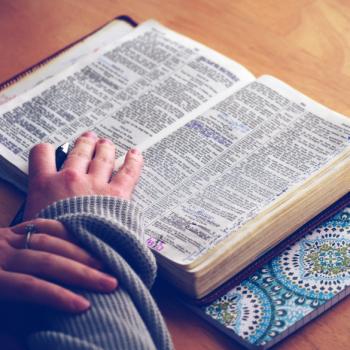
Every time debate about the so-called “Billy Graham rule” flares up (the current drama surrounding Matt Chandler being no exception), someone inevitably points out that Jesus himself broke the Billy Graham rule. As evidence of this, they’ll point to Jesus’ conversation with the woman at the well in John 4. Jesus, they say, is apparently capable of being alone with a woman for an extended period of time without having any kind of sexual or romantic intentions.
And, while this may work well enough as an argument against the Billy Graham rule, I think it leaves something to be desired as an interpretation of John 4. In fact, I believe that John’s gospel goes out of its way to portray the interaction between Jesus and the Samaritan woman as a romantic exchange! The John 4 text is therefore one of many passages in scripture which deal with the theme of Jesus and his people as bride and groom, something which I’ve been writing about regularly.
So today, I want to lay out three reasons why I’ve come to the strange conclusion that John’s gospel portrays Jesus’ conversation with the woman at the well as part of Jesus’ calling of his bride, the church. (Discussion of the merits of the Billy Graham rule itself will have to wait for another time.)
Well, Well, Well—Three Historical Examples
The first bit of evidence that the “bride of Christ” idea is lurking in the background of Jesus’ conversation with the Samaritan woman is some historical context.
Consider: how do men meet their wives in scripture? Well, in the case of Isaac (Genesis 24), Jacob (Genesis 29), and Moses (Exodus 2), they all meet their wives at wells. In fact, men meeting their wives at wells occurs frequently enough in the Old Testament that Jewish scholar Robert Alter uses it as the definitive example of what he calls a “type scene”—a similar scene repeated throughout the text.
And we should point out that the well is not the only similarity between the three Old Testament stories. In fact, except for the fact that Isaac finds his wife by proxy (Abraham’s servant goes in his stead), the stories are eerily similar in almost every respect.
In each case, the young biblical hero, the would-be husband, leaves his homeland and goes to a foreign land where some distant family relations live. He waits at a well. A girl comes. The man and girl assist each other in drawing water. The man identifies himself and the girl rushes home to tell her family about him. It’s the same pattern, even in the details.
Of course, as you’ve probably already guessed, the story of John 4 fits this pattern perfectly. Jesus leaves his homeland (Judea) and goes to a foreign land (Samaria) where some distant family relations (the Samaritans) live. He waits at a well. A girl comes. They discuss who is supposed to provide water for whom. He reveals his identity, and she rushes off to tell her family about him.
And, just in case we’re not picking up on the patriarchal connection, John 4 mentions three times that Jesus and the Samaritan woman are at Jacob’s well. John’s subtly suggesting to us that we should make the connection between this scene and conversations at wells in the days of the patriarchs.
“He is the Bridegroom”
But the historical context is not the only evidence that marriage is the subtext of Jesus’ conversation with the woman at the well. The context within the broader story of John’s gospel also gives us evidence that John is working with the bride-of-Christ theme.
In fact, if we turn back to John 3, in the scene right before Jesus meets with the Samaritan woman, we find John the Baptist making an interesting declaration. John’s disciples are concerned that Jesus is stealing the crowds away from him… and this is what he says about it.
You yourselves bear me witness, that I said, ‘I am not the Christ, but I have been sent before him.’ The one who has the bride is the bridegroom. The friend of the bridegroom, who stands and hears him, rejoices greatly at the bridegroom’s voice. Therefore this joy of mine is now complete. He must increase, but I must decrease.
Did you catch it? John the Baptist calls Jesus the bridegroom three times. And John says that he rejoices that Jesus has come—he knows that God is making good on his promise to Israel that, despite their unfaithfulness, he would one day come and “betroth them to [Him] forever” (Hosea 2:20).
Moreover, if we expand our lens a little more, we find even more aspects of John’s gospel which are playing on the theme of weddings. In John 2, we see the wedding at Cana, where Jesus outdoes the groom by providing better wine for the feast… And, back in John 4, after the conversation with the Samaritan woman, John tells us that Jesus goes back to Cana “where he had made the water wine.”
Weddings, brides, and grooms provide the entire narrative backbone of John 2-4, and John ties it off with a neat little bow with that final reference back to Cana.
“Go, Call Your Husband”
The final bit of evidence that the John 4 passage is really about Jesus calling the Samaritan woman to be a part of his bride, the church, is that it makes sense of the conversation about the Samaritan woman’s love life.
We all know the story. Jesus asks for a drink of water. The woman is confused. He then promises her living water, which confuses her some more. But after a while, she asks him to give her the living water and he responds by saying “go, call your husband, and come here.”
For most of my life, I thought this command came totally out of nowhere. What in the world does the woman’s husband have to do with the conversation at hand? But if marriage is the entire subtext of the passage, the unspoken backstory looming behind an offer of a drink at a well, then it’s only natural that the woman’s love life would come up!
And notice the details of that love life! The woman has had five husbands and the man she’s with now is not her husband. Six men, just one shy of seven, the biblical number of perfection and completeness. She’s waiting on that seventh suitor, the perfect bridegroom. She’s been waiting for Jesus to come and call her to be his.
The Biblical Love Story
Ultimately, I believe that Jesus’ conversation with the Samaritan woman in John 4 is one small piece of the broader biblical story of God and his people as bride and groom.
In that story, God first calls his bride out of slavery, like a man rescuing an orphan from the mud (Ezekiel 16). He cleans her, loves her, and showers her with fine food and clothes, but she’s unfaithful. She follows after other gods and is hauled off into exile. But he nevertheless promises restoration (Hosea 2). He sends his son to wash her clean (Ephesians 5), and he looks forward to the day when she will be presented to him in perfect splendor, “clothed in fine linen, bright and pure” (Revelation 19). God’s bride may start off rejected. She may start off sinful. But the good news of the gospel is that he’s determined to rescue her because of his steadfast love.
And Jesus’ dealings with the Samaritan woman are a perfect picture of the kind of redeeming, gospel love that God always shows to his bride. The Samaritan woman is an outcast and a sinner. She would have been reviled by the Jews for being a Samaritan, and reviled by the Samaritans for being an adulterer. But Jesus overcomes all of those barriers with his offer of love and salvation. He fills her with living water, and her joy overflows as she runs to tell others about him, leaving her water jar behind. What a tremendous picture of how he treats each and every one of us.
Questions or comments about John 4 or my interpretation? Please leave a comment below.
Also, if you’ve been intrigued by this interpretation of John 4 or the broader story of God and his people as bride and groom, consider following me on Twitter to hear about my latest articles. I’m going to be exploring this topic a lot over the coming months! I’d love for others to follow along and share their thoughts and ideas with me.












